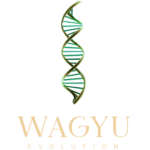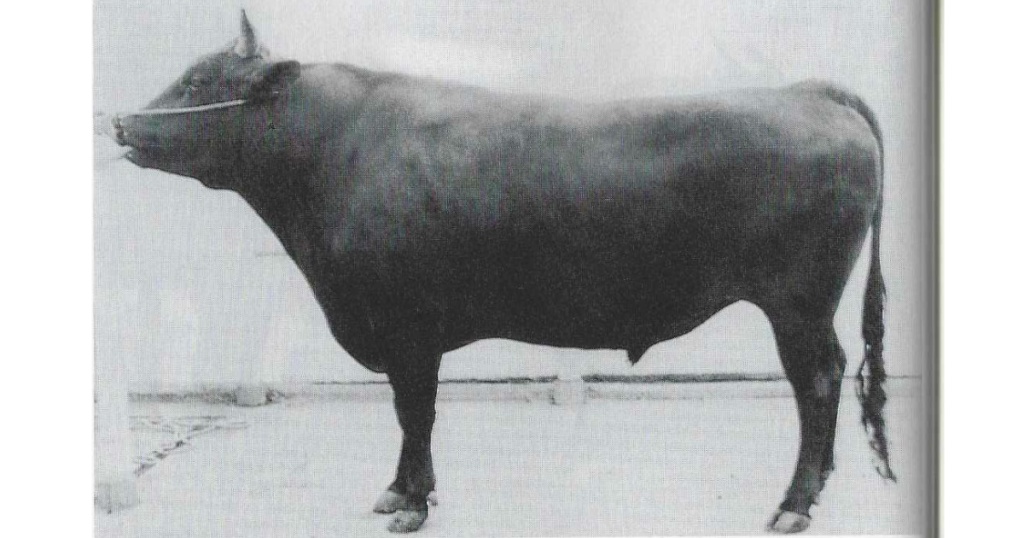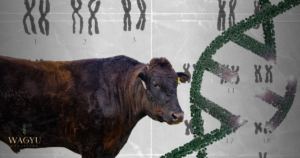Tanifuku-Doi: A Representative Breeding Bull of the Hyogo Prefecture
Table of Contents
* Note: This is not a direct translation of Kenichi Ono’s “Top 100 Famous Beef of Japan [Revised Edition]” but a summary that was written using it as a direct source.
Early Life
Tanifukudoi was born on March 8, Showa 60 (1985), at the home of Mr. Mitsuyoshi Nagase in Muraoka Town, Hyogo Prefecture. His mother was the super-famous cow, Kikutetsugo, and his father was Ankoku Doi, who at the time was regarded as the number one breeding bull in Japan due to his great success with Anfuku. His sibling bulls include Dainiankakudoi (father: Anmidoi, born in 1979) and the mothers of the business association’s Kikuan, “Kikutsuru 5,” “Kikutsuru 7,” and “Kikutsuru 8,” among others.
As an elite bull from birth, Tanifukudoi became the property of Hyogo Prefecture and has been active as Ankoku Doi’s successor bull up to the present. During the indirect testing that ended in 1990, the final average weight was 493 kg, average carcass weight was 311 kg, daily gain (DG) was 0.80 kg, Beef Marbling Standard (BMS) was 3.2, and the ribeye area was 46 cm², recording the highest BMS for Hyogo Prefecture under the new testing method.
Hyogo Prefecture has traditionally implemented closed breeding with a focus on creating bulls that emphasize maternal traits. However, the decline of the Shigekanenami line, which had shown good growth and maternal capabilities, led to increasing the inbreeding coefficients of Anmidoi and Kikunoridoi. This eventually led to stagnation in growth improvement. Particularly, the loss of Anfuku, who excelled in both growth and meat quality among Tajiri-line cattle, to Gifu Prefecture was one of the unfortunate events for Hyogo’s breeding improvement.
Tanifukudoi is one of the few bulls left in Hyogo that has passed down the excellent growth and meat quality of Ankoku Doi to future generations. As of April 1997, it is estimated that about 60,000 straws (semen) have been produced. Bulls such as Kintsuru, Mitsufuku (from the Livestock Improvement Association), Ushiwakamaru (Nagasaki), and Kamifuku (Miyazaki) are among them.
Features
Strengths: Good ribeye area, early maturity, balanced body shape, thick shoulders, good meat color, etc.
Weaknesses: Increased weakness and fat necrosis when inbreeding is intensified, facial quality, (slight weakness in growth), etc.
Tanifukudoi has consistently shown stable performance as a fattening calf, and can be considered a more compact version of the peak-era Gifu’s Anfuku or the current Anpei. The ribeye area is also large, and as a Hyogo bull, it has thick shoulders, good ham lines, meat color, and texture. However, when compared to bulls like Anpei, it cannot be denied that it has slightly less growth potential, which, while recognized in the Kobe market, has not made it particularly stand out in the Tokyo or Osaka markets.
When comparing the indirect test data of Hyogo bulls over the past 20 years in Table 6, it is clear that while fat marbling is good, improvements in growth and robustness have not progressed much, as shown by objective data. This may indicate the limitations of closed breeding, as the improvement of purebred Hyogo bulls in regions like Miyazaki, Miyagi, and Kagoshima has surpassed Hyogo both in data and in actual calf market prices.
Pedigree Background
Tanifukudoi’s father, Ankoku Doi, was the masterpiece of his grandfather, Anmidoi, and was the highest-ranked bull in the history of Japanese Wagyu, known for its excellent fat marbling as well as its frailty.
Born in 1976, Ankoku Doi passed away early in 1982. Representative bulls include Anfuku (Gifu), Ankokufuku (Kagoshima), Fukutomi (Hokkaido), Ankin, Tanishige, Tanihide (Livestock Improvement Association), Kikutani, Anpa, Fukujin (Iwate), Tanimoto Doi, Tanimidoi (Hyogo), Taniandoi (Kagoshima), Taninobu (Nagasaki), and Osho (Yamagata).
Tanifukudoi’s mother, Kikutsuru, is a foundational cow representing the maternal line of Hyogo Prefecture. Kikutsuru’s father, Kikumidoi, was a descendant of Tajiri, but due to its uniqueness, it has been classified as the progenitor of the Kikumidoi line. The third-generation mother, Shofuku 3, was the daughter of Tafukudoi, who was the grandfather of Anmidoi, and Tafukudoi was also a descendant of Tajiri. Therefore, Kikutsuru can be considered a cow produced by sibling mating. The fourth-generation ancestor, Isuzu, was also a famous cow directly descended from Tajiri, born during the war. The fifth-generation ancestor was Iwakura from the Nakadoi line, the sixth-generation mother was Marugame, the sixth-generation ancestor was Dainimarumi, the seventh-generation mother was Kame, and the seventh-generation ancestor was Kawaai. These details have been traced through research.
Main Successor Bull Candidates
Tanifukudoi’s offspring breeding bulls were extensively produced around 1990 to 1992, before and after the completion of indirect testing, and have been used nationwide. A common feature is that many of these bulls strongly express the abilities of their maternal line, but they are also prone to early death due to fat necrosis, requiring careful management, similar to Ankokudoi and Anfuku.
- Kintsuru (Kumamoto Livestock Improvement Association)
Kintsuru was auctioned at a high price by the association in Heisei 3 (1991) and is an elite bull, a half-brother to Ankin (father: Ankokudoi). In the same batch, there were three outstanding Tanifukudoi offspring, Fukukin, Tanifuku, and Kikufukutan, with Fukukin achieving the top BMS score of 2.3, but Kintsuru is currently outperforming them in field performance and popularity.
Kintsuru is characterized by its robustness and good growth compared to his brother Ankin, and it has shown that even with slight inbreeding, its abilities do not significantly diminish.
Additionally, the compatibility with high-performance cattle from the Shimane lineage, such as Hokugoku 7-8, is excellent, and it can be judged that its economic value is higher than that of Monjirou and Mitsufuku, which will be mentioned later. It is recommended to actively retain female cattle with good growth potential.
- Mitsufuku (Okayama Livestock Improvement Association)
Since 1995, the association has established two testing stations (in Hokkaido and Hiroshima Prefecture), revised the feeding system, and increased the number of dehorned and test animals to prevent variability and improve the accuracy of results. Mitsufuku was born as one of the first bulls from this new testing system.
Among the 26 bulls in the same test group, Mitsufuku had an average BMS of 3.3 (based on 14 test animals), which was significantly higher than the second-place bull, Otojirou (father: Monjirou), who had a BMS of 2.4 (based on 15 test animals). This indicates just how outstanding Mitsufuku’s results were.
Additionally, the association’s testing is characterized by diverse maternal lineages, and despite this variability, Mitsufuku’s consistent BMS scores, with a minimum of 7 and a maximum of 12, are proof of its high ability. However, it should be noted that there was variability in growth, with some Shimane lineage cows achieving 439 kg and others as low as 290 kg, highlighting a key consideration for future breeding.
It should be added that Mitsufuku’s indirect test BMS score was the second highest among the bulls tested in 1996, following Hida Hakusei (Gifu).
- Ushiwakamaru (Nagasaki Prefecture)
Ushiwakamaru became famous as the top bull in Japan for the indirect testing completed in Heisei 6 (1994). Nagasaki Prefecture has been importing one breeding bull from Hyogo annually, and Ushiwakamaru was one of these bulls.
Ushiwakamaru was introduced in Heisei 4 (1992). Nagasaki Prefecture has traditionally focused on independent improvements centered on Shigenami lineage bulls. However, due to stagnation in growth, they have actively introduced Itozakura lineage bulls from Shimane Prefecture, as well as Doi lineage bulls from Hyogo and Kagoshima Prefectures, to enhance economic performance.
Ushiwakamaru’s maternal lineage is from the Mitsufuku lineage, a famous bull descended from Kikumidoi, similar to the aforementioned Mitsufuku. This lineage is known for stable meat quality, high fertility, and longevity. Since Tanifukudoi’s maternal lineage is also from the Kikumidoi lineage, specifically “Kikutsuru,” the inbreeding coefficient is quite high. Perhaps due to this, Ushiwakamaru, initially expected to become a star across Kyushu after completing indirect testing, has faced issues with variability in growth and has lost popularity to Itoharumi, a bull from the Itozakura lineage. However, if careful selection is made for breeding, Ushiwakamaru is still expected to perform quite well in the future.
- Kikufukutsuru (Hokkaido Livestock Improvement Association)
Kikufukutsuru was a breeding bull produced by Mr. Mitsuyoshi Nagase, the breeder of Tanifukudoi. The mother, Kikutsuru 7, was Tanifukudoi’s sister. Perhaps due to this, Kikufukutsuru died prematurely from fat necrosis before the indirect testing was completed in Heisei 6 (1994).
Despite this, the indirect test completed in Heisei 7 (1995) showed excellent results, and the few offspring have achieved the expected high performance. When the maternal lineage is from Hyogo, growth performance tends to be extremely poor, so female cattle with growth types from Shimane or Tottori Prefectures are considered ideal breeding partners.
- Tanishiro (Oita Prefecture)
Even in Oita Prefecture, known for Itofuku, excellent successor bulls of Tanifukudoi are being used. During a period when Itofuku and Itoden lineage breeding cows are increasing, Tanidai, along with Tanigawa (father: Yaefuku) from the Hyogo lineage, is expected to make significant contributions in the future.
- Kamifuku(Miyazaki Prefecture Livestock Improvement Association)
In Miyazaki Prefecture, where Anpei (a famous bull) reigns supreme, Kamifuku, who achieved top-class indirect test results in Heisei 7 (1995), has emerged as a noteworthy bull. Like Mitsufuku and Ushiwakamaru, Kamifuku carries the bloodline of Mitsufuku in his maternal lineage. If the somewhat weak points can be addressed through breeding, significant improvements in meat quality can be expected.
Other bulls like Tanikiku, Fukutsuru, Fukutanifuku (Livestock Improvement Association), Yoshitsune, Taneyoshi (Iwate), Shofuku (Fukushima), Tagosakudoi, and Shichifukujin (Hokkaido) are also anticipated to perform well in the future.
Breeding Considerations & Recommendations
As a Hyogo lineage, the Tanifukudoi line has satisfactory growth and generally thicker ribeyes. However, as breeding cows, they tend to have slightly shorter body length and are prone to fat accumulation. Therefore, it is ideal to cross them with the No. 20 Hiramochi lineage or No. 7 Itozakura lineage to compensate for shortcomings in body length, milk production, and fat necrosis. However, it’s important to be cautious of potential difficulties in the first calving.
For Anya Doi, Tanifukudoi, Anfuku, Kikutsuru, Mitsufuku, Omizo, and other paternal and maternal lines that are often closely related, it is particularly important to check the inbreeding coefficient before mating to prevent reduced growth and vulnerability.
References
小野健一. 日本名牛百選〔改訂版〕(pp.71-76). 肉牛新報社.




